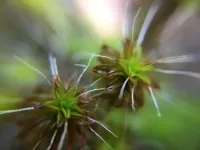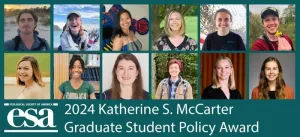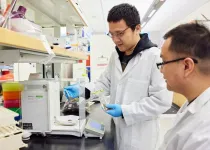Imagine: You find the dried-up remains of a once green and lush philodendron on your bookshelf and realize you can’t remember the last time you watered your houseplants. You soak the soil with water, hoping you can breathe life back into its desiccated husk, but it is futile. The plant has been too dehydrated for too long, and irreparable damage has been done.
Now imagine that it isn’t your neglected houseplants that have been subjected to an unexpectedly dry growing season, but a field of wheat. With changes in global climate, such things are becoming more common and more of a concern for farmers, consumers, and researchers alike as the threat to food security intensifies.
But what if plants could withstand periods of harsh, dry environmental conditions? What if they could dry out but still remain viable, such that when water is again abundant, they spring back to life?
This concept, “drying without dying” or desiccation tolerance, was an adaptation that allowed plants to colonize land and is still utilized by select species throughout the plant kingdom. In a newly published study in New Phytologist, an interdisciplinary team featuring researchers from the Boyce Thompson Institute (BTI) explored the evolution of this phenomenon in a group of mosses and found a common thread that traces through 450 million years of plant evolution.
This study was part of a larger effort to understand the biodiversity of mosses, with a focus on Syntrichia species. These particular mosses have critical ecological roles in dryland biocrusts, described as the “living skin of the earth” by Dr. Brent Mishler, a Professor at University of California, Berkeley, and one of the lead researchers on the project. It is a complex community of organisms that forms a literal crust on the soil surface and serves to maintain the stability and fertility of the soil beneath, similar to how the microbiome of human skin plays essential roles in our own health.
Dr. Melvin Oliver, retired USDA researcher and current adjunct professor at the University of Missouri-Columbia, has studied these mosses for forty years and assembled a diverse group of researchers to work on various aspects of the project, from genomics and transcriptomics to phylogenetics and physiology. Building upon a previous exploration of the Syntrichia caninervis genome, this study saw the sequencing and assembly of the Syntrichia ruralis genome and the profiling of gene expression changes that accompany the dehydration and rehydration of these two species.
“These species are very closely related but also have these hard lines in the sand, literally, in the desert, where they live in different habitats,” explains Dr. Jenna Ekwealor, an Assistant Professor at San Francisco State University and co-lead author on the manuscript. She describes S. caninervis as a specialist in dry environments while S. ruralis, a generalist, can thrive in environments with a wider range of water availability.
Both S. caninervis and S. ruralis are desiccation tolerant, but given their specific environmental preferences, they may have slightly different strategies (i.e., use different molecular tools) for drying and rehydrating. By comparing how these two species manage the resurrection process, we can gain an understanding of how mosses cope with water scarcity and how those mechanisms have evolved. Interestingly, insights from the paper suggest that these closely related mosses use similar pathways to coordinate the dehydration process but differ in how they manage rehydration—something that will require further investigation.
Understanding moss mechanisms of desiccation tolerance may shed light on similar processes in flowering plants. In a process reminiscent of moss resurrection, the seeds of flowering plants dry out as they mature, bringing them into a state of dormancy that allows them to survive until environmental conditions are optimal.
MYB55, a regulator identified by BTI postdoctoral researcher Xiaodan Zhang, is present in mosses and flowering plants and appears to play roles in resurrection and seed dormancy. This speaks to “a conserved evolutionary mechanism across different plant species,” as Dr. Zhang describes, “which provides insights into the evolution of plant stress responses and how certain key genes have been preserved and repurposed throughout evolutionary time.”
It is interesting to see how these desiccation tolerance tools have not been lost as flowering plants evolved but instead have been delegated to specific plant tissues at particular life stages for specialized purposes. Co-corresponding author Dr. Andrew Nelson, an Assistant Professor at BTI, hopes to take advantage of these evolutionary connections to identify other conserved aspects of water scarcity responses.
It might seem strange to look to mosses for inspiration for developing more resilient crops. Dr. Oliver is familiar with the skepticism, having conducted his research at an institution mainly focused on agriculture. But he says, “I’d take this dried up little piece of moss and put it in their hand and then squirt a bit of water on it, and thirty seconds later you’ve got this bright little green plant that’s perfectly alive… It’s basically, how do plants survive drying?” A particularly pertinent question.
These mosses have the tools to cope with harsh environmental conditions, tools that have remained in one form or another through 450 million years of evolution. With a better understanding of how the resurrection process works, we can potentially harness these mechanisms to make crops, and even neglected houseplants, more resilient in the face of a changing climate.
About the Boyce Thompson Institute
Founded in 1924, the Boyce Thompson Institute (BTI) is a premier plant biology and life sciences research institution located in Ithaca, New York. BTI scientists conduct investigations into fundamental research with the goals of increasing food security, improving environmental sustainability, and making basic discoveries that will enhance human health. Throughout this work, BTI is committed to inspiring and educating students and providing advanced training for the next generation of scientists. BTI is an independent nonprofit research institute that is affiliated with Cornell University. For more information, please visit BTIscience.org.
About New Phytologist
New Phytologist is a leading international journal focusing on high quality, original research across the broad spectrum of plant sciences, from intracellular processes through to global environmental change. The journal is owned by the New Phytologist Foundation, a not-for-profit organisation dedicated to the promotion of plant science. https://www.newphytologist.org/
END










